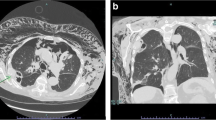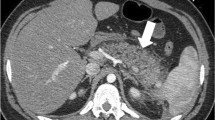Abstract
Pleuroperitoneal communication is a severe complication in peritoneal dialysis, and about half of the patients forced to discontinue peritoneal dialysis. The method of coloring dialysis solution by indocyanine green or CT peritoneography have been reported to make diagnosis of pleuroperitoneal communication, however sensitivity of these tests is not a satisfactory level. By repairing the pleural hole with thoracoscopic surgery, it is possible to resume peritoneal dialysis. However, the recurrence rate is very high unless precisely detecting the location of the pleural hole during surgery. We report three cases of pleuroperitoneal communication in peritoneal dialysis patients, in which we found the combination of contrast-enhanced ultrasonography and the indocyanine green fluorescence system are reliable method to make diagnosis and identify the location of leakage of pleuroperitoneal communication. By making definite diagnosis and precisely identifying the localization, we were able to close diaphragm holes by video-assisted thoracoscopic surgery.



Similar content being viewed by others
References
Nomoto Y, Suga T, Nakajima K, Sakai H, Osawa G, Ota K, et al. Acute hydrothorax in continuous ambulatory peritoneal dialysis-a collaborative study of 161 centers. Am J Nephrol. 1989;9:363–7.
Saito M, Nakagawa T, Tokunaga Y, Kondo T. Thoracoscopic surgical treatment for pleuroperitoneal communication. Interact Cardiovasc Thorac Surg. 2012;12:788–9.
Edward SR, Unger AM. Acute hydrothorax–-a new complication of peritoneal dialysis. JAMA. 1967;199:853–5.
Momenin N, Colletti PM, Kaptein EM. Low pleural fluid-to-serum glucose gradient indicates pleuroperitoneal communication in peritoneal dialysis patients: presentation of two cases and a review of the literature. Nephrol Dial Transpl. 2012;27:1212–9.
Tang S, Chui WH, Tang AW, et al. Video-assisted thoracoscopic talc pleurodesis is effective for maintenance of peritoneal dialysis in acute hydrothorax complicating peritoneal dialysis. Nephrol Dial Transpl. 2003;18:804–8.
Kang TW, Kim CK. Pleuroperitoneal communication of peritoneal dialysis demonstrated by multidetector-row CT peritoneography. Abdom Imaging. 2009;34:780–2.
Puls R, Gebauer B, Hildebrandt B, et al. Intraperitoneal distribution of ultrasound contrast medium imaged with B-mode ultrasound and colour-stimulated acoustic emission imaging. Eur Radiol. 2003;13:695–9.
Matsumura M, Mizutani E, Suzuki T, et al. Successful diagnosis and treatment of peritoneal dialysis-related pleuroperitoneal communication by contrast-enhanced ultrasonography and thoracoscopic surgery. Perit Dial Int. 2017;37:485–6.
Di Bisceglie M, Paladini P, Voltolini L, Garosi G, Ghiribelli C, Di Paolo N, et al. Videothoracoscopic obliteration of pleuroperitoneal fistula in continuous ambulatory peritoneal dialysis. Ann Thorac Surg. 1996;62:1509–10.
Nakayama T, Hashimoto K, Kiriyama T, Hirano K. Optimal imaging conditions for the diagnosis of pleuroperitoneal communication. BMJ Case Rep. 2019;12:e228940.
Kawakita N, Takizawa H, Kajiura K, Tangoku A. Indocyanine green fluorescence intraoperative imaging for hepatic hydrothorax with a small diaphragmatic defect. Semin Thorac Cardiovasc Surg. 2016;28:606–8.
Author information
Authors and Affiliations
Corresponding author
Ethics declarations
Conflict of interest
All authors have declared no competing interests.
Ethical approval
All procedures performed in studies involving human participants were in accordance with the ethical standards of the institutional and/or national research committee at which the studies were conducted and with the 1964 Helsinki declaration and its later amendments or comparable ethical standards.
Informed consent
Informed consent was obtained from all individual participants included in the study.
Additional information
Publisher's Note
Springer Nature remains neutral with regard to jurisdictional claims in published maps and institutional affiliations.
About this article
Cite this article
Inanaga, R., Oda, M., Asahina, K. et al. The new method to make diagnosis and identify the location of leakage of pleuroperitoneal communication in peritoneal dialysis patients. CEN Case Rep 11, 471–476 (2022). https://doi.org/10.1007/s13730-022-00701-6
Received:
Accepted:
Published:
Issue Date:
DOI: https://doi.org/10.1007/s13730-022-00701-6




